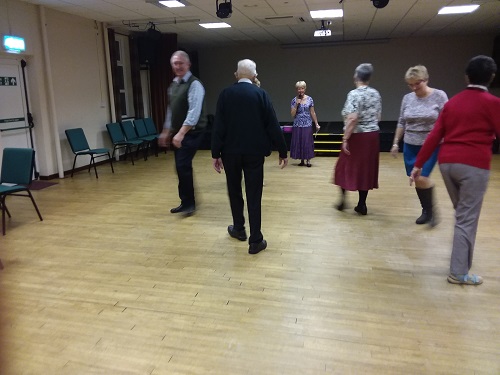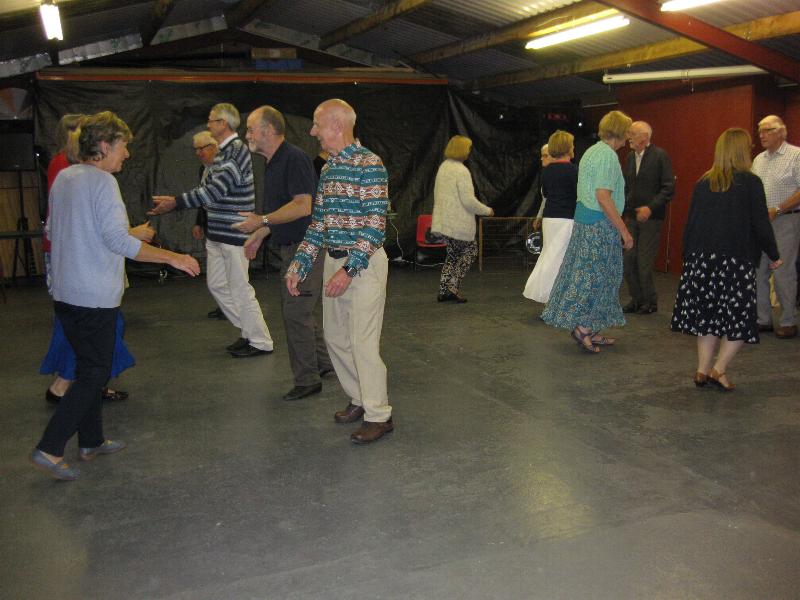Folk Dance Explanations
Dance Formations.
| Longways Set | Set made up of lines of men facing their partners in a Long Set viz:- |
The Music or The Presence.
| Left of Room | Right of Room |
| Men’s Side | Ladies Side |
| Duple-Minor Set | A progressive longways set in units of two couples. Ones remain ones to the bottom while twos remain twos to the top when each has a turn out before changing numbers and returning along the set having changed numbers |
| Triple-Minor | A progressive longways set in units of three couples. First couple progresses down the set one place and keep their number to the bottom. The other two couples alternate between two and three and move up to the top of the set. |
| Beckett Formation | A progressive longways set but men with their partners by their right side facing another similar couple across the set. Progression is along the side of the set. |
| Long Sets | 3, 4, 5 or more couples dance in a long set. |
| Double Circle | Face partners with men on inside and ladies on outside. |
| Sicilian Circle | Couple facing couple in a large circle around the room. |
| Double Sicilian Circle | Two couples side-by-side facing two couples side by side and forming a circle around the room. |
| Square | Four couples forming sides of square and numbered anticlockwise starting with the couple that has their backs to the Presence. Head couples are numbers 1 and 3. Side couples are numbers 2 and 4 |
Always join a set at the bottom unless invited to do otherwise.
Folk Dancing is a contact dance. Men lead or guide lady to place.
Remember to move up as the dance progresses to prevent a crush at one end of the room.
Other than when in a ‘square formation’ keep the sets close together to make dancing easier – pairs of dancers should be at no more than ‘arms length’.
Dance Positions
| Contra or Opposite | The other lady or man in a Longways four-hand set when all are ‘proper’. |
| Corner | The person on the opposite side from partner in a square set. |
| Inside hands | Hands nearest partner. |
| Neighbour | The other lady or man in a Longways four-hand set when one couple is ‘improper’. |
| Proper | Men with their lady on the right when facing up towards the ‘Presence’, usually known as man’s side and lady’s side. |
| Improper | Men with their lady on the left when facing up towards the ‘Presence’, i.e. man on lady’s side. |
Basic Terminology
| Allemande | Join R or L hand as instructed and turn around each other, |
| Balance | Hop onto right foot – crossing left foot in front. Then Hop onto left foot – crossing right foot in front (usually precedes a swing) |
| Cast | To turn out away from the set and move down behind other dancers. |
| Contra or Opposite | The other lady or man in a four hand set. |
| Courtesy Turn | Partners hand in hand – men moving backwards help their current partner round to face in or out of the set as directed. |
| Cross | Change places with the person indicated – passing by the right shoulder |
| Do-sa-do or Back to Back | Dancers pass by the right shoulder, step to right and move backwards to Back to Back place without turning. |
| Grand Chain | Partners facing each other round a ring – starting with R hand take alternate hands moving around the circle. |
| Gates | One couple acting as ‘posts’ take inside hands with neighbour-help them round and finish all facing into the set. |
| Grand Chain | Partners facing each other round a ring – starting with R hand take alternate hands moving around the circle. |
| Gypsy | Similar to allemande – but without hands. Face each other all way round passing L or R shoulder as instructed. |
| Figure of Eight | In fours in long set: – Couple face couple (lady going first) cross between the other couple and dance a figure eight round the them finishing in original places. |
| Half Figure Eight | as above but only dance half way to finish in partners place. |
| Half Promenade | Promenade to change places with couple facing (See promenade). |
| Hands Four | Four dancers join hands in a ring. |
| Ladies Chain | Couple facing couple, Ladies take right hand and pass each other, giving left hand to opposite man, who places right hand on ladies waist and helps her round behind him. Repeat back to starting position |
| Promenade | Couples cross hands, right hand to right and left hand to left and walk facing forward |
| Reel | For 3 or 4, weaving past each other passing alternate shoulders back to original place. Usually start by passing by the right shoulder. |
| Right and Left Through | In fours: Take right hand of opposite and dance past, turn to partner, take left hands and change places. Repeat back to place. Turn the shortest way in the direction you are moving i.e. Walk the shortest way round a square |
| Siding | Two types – Sharpe or ‘curly’ – similar to ½ two hands turn to left followed immediately by ½ two hand turn to right – but without taking hands with the other dancer. Shaw or To the Shoulder – dancers move forward a double to meet ‘shoulder to shoulder’ and fall back looking at each other all the time. L. or R. as instructed |
| Star | Put right or left hands into middle and walk around. Dancers should hold the opposite’s hand there should not be a ‘bunch of bananas’. |
| Swing | Ballroom hold, with weight mainly on the right foot which is placed outside by outside with partner. Dropping onto this foot, pivot with partner in clockwise direction, using left foot to transfer weight while moving right foot. |
| Turn | Walk round each other, holding hands (See Allemande). |
| Turn Single | Each dancer turns alone on the spot taking 4 steps in the process. |



